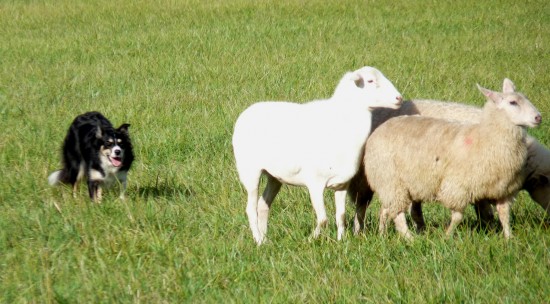In the first article we looked at Julie Carter’s work training stock dogs at Meadow Oak farm. We discovered that successful stock training is about relationship and co-operation. It is the partnership between dog and trainer that makes for successful herding. Now we will look at the details of how this teamwork is achieved.
This balanced dance of dog and sheep, choreographed by the trainer, starts in a small round pen. The goal: to get the dog comfortable with the sheep and “defuse their need to bite.” Julie explained that “the dog will only use their mouth when they’re under pressure and stressed. We talk calmly and quietly and block them with our body to prevent them from coming onto the sheep with their mouths. We stay with the sheep at all times as the dog goes around them to protect the sheep.”
It’s important to use ‘dog broke’ sheep, ones that come to the handler for safety. If the sheep don’t come to the handler it’s dangerous for the sheep.”
We also pack a lot of sheep in a small pen and take the young dog around them to see them close, smell them and learn not to be scared. This helps a lot with the need to nip. Very few border collies that are bred for sheep herding bite, and it’s forbidden in the world of sheep trials.”
A typical training session will be 10 -15 minutes in length as the young dog is under pressure from both handler and sheep and is being asked for total self-control. The dog and the sheep tire quickly, and tired sheep can make mistakes – splitting away from the pack, putting them-selves in danger.
Once the two dancers, the sheep and the dog, are familiar with each other they’re ready to train in a small 100- by 100-meter field. Then, as the dog becomes a controlled obedient partner with the trainer, they are ready for the big field.
Julie also shared a bit about the commands and the breed. Lie down means stop. The dog can choose to lie down or stand, as long as she stops. The bigger and younger dogs usually choose to stand because laying down makes them slow when speed is required to round up stray sheep. I asked about the use of the whistle. The whistle is blown to tell the dog which flank, or side of the herd, to go to. To get the dog to go in the direction the trainer wishes, the whistle is blown followed by the vocal command. If the dog goes the wrong direction the trainer says “uh.” This let’s the dog know to stop and go the other way. Gradually the voice command will be dropped.
This breed of collie controls the herd with their eyes by staring the sheep down. The technique is one of predator and prey. Sheep move ahead of the dog out of fear. The trainer teaches the dog boundaries, and to keep sheep moving in a calm, controlled manner. Collies only nip on the nose in self-defense if a ewe becomes aggressive.
Julie and her dog’s train 12 months a year – rain or shine. Only a bad snowfall might stop them. Her future goals are to compete in the USA finals and be invited to compete at the Soldier Hollow trial in Salt Lake City. We wish Julie the best and thank her and her dogs for the wonderful show of skill we so enjoy watching from our perch at the Deep Cove Market.
First posted at SS Times January 2011
Photo Credit



I have a border collie named Whiskey that would be amazing at this herding thing, I should try it out with him and see what happens, now if I can just get him to put the Frisbee down. lol